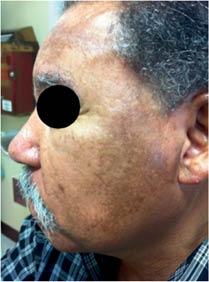Skin type
Skin color
Sunburn and tanning history
I
White
Always burns, never tans
II
White
Always burns, tans minimally
III
White
Burns moderately, tans gradually
IV
Olive
Minimal burning, tans well
V
Brown
Rarely burns, tans darkly
VI
Dark brown
Never burns, tans darkly black
Melasma is an acquired patchy hyperpigmentation predominantly occurring in individuals with Fitzpatrick skin phototypes III and IV. It is a common disorder affecting nearly 5 million people in the U.S. alone. Although most frequently seen in women, 10% of cases occur in men. The reported prevalence ranges from 8.8% of Hispanic women in the Southern U.S. to 40% of Southeast Asian females.3
Melasma occurs primarily in 3 clinical patterns: 1.) centrofacial, 2.) malar, and 3.) mandibular, although many patients have a mixture of these presentations (Figure 1). The most common is centrofacial and consists of light to dark brown patches occurring on the forehead, cheeks, nose, upper lip, or chin. The malar pattern affects the cheeks and nose, while the mandibular pattern occurs along the jawline.

Figure 1 Melasma
The clinical manifestations of melasma are thought to result from the presence of biologically hyperactive melanocytes in the affected skin. The exact etiology of melasma remains unknown, however, several risk factors have been identified. Affected individuals frequently have a family history suggesting the influence of genetics.
In addition, sun exposure is a common exacerbating factor most likely through upregulation of melanocyte-stimulating factors. The high incidence of melasma in women, especially those who are pregnant or taking oral contraceptives, suggests an important role for estrogen.
Stay updated, free articles. Join our Telegram channel

Full access? Get Clinical Tree








